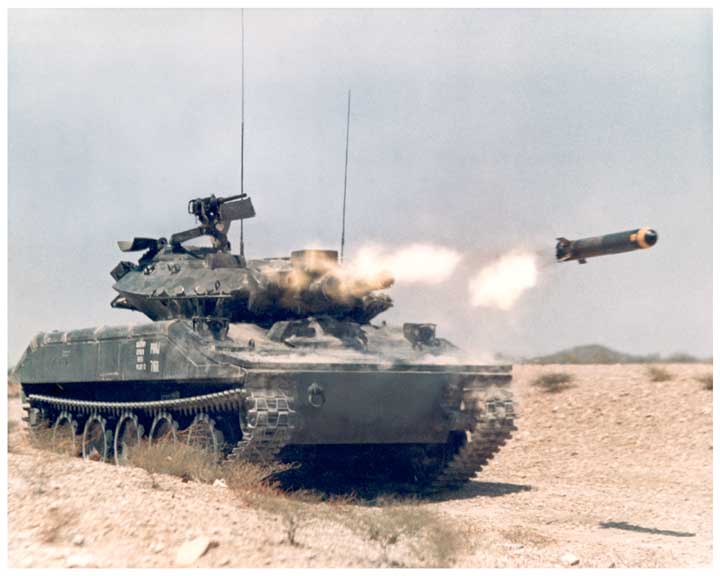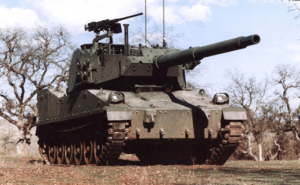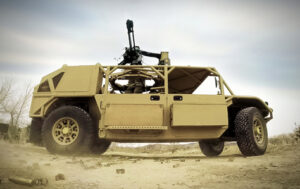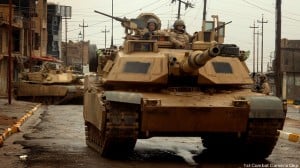
The new Mobile Protected Firepower vehicle (MPF) will be the first lightly armored, heavily armed vehicle in Army service since the M551 Sheridan, pictured.
This week at Fort Benning, Ga., the Army told some 200 industry representatives from 59 companies what it wants in its next war machine, the Mobile Protected Firepower vehicle (MPF).
The MPF must be light and nimble enough to accompany foot troops where the massive M1 Abrams cannot go: into dense jungle and narrow streets, up mountains and over rickety Third World bridges. It must also carry enough armor to shrug off .50 caliber machinegun fire and some heavier weapons. It must pack enough firepower to take out anything from a concrete bunker to a heavy tank.
That’s ambitious. Combining mobility, firepower, and protection in a lightweight and affordable package is hard — so hard that this is the Army’s fourth try in 20 years. The M8 Armored Gun System was cancelled in 1996 to save money. The Future Combat System was cancelled in 2009 because its ambitious high technology wasn’t working. The Stryker Mobile Gun System (MGS) managed to enter service, but to widespread dissatisfaction.

The M8 Armored Gun System, canceled in 1996.
The Army is determined to do better this time.
“Our near-peers have sought to catch up with us,” said Fort Benning commander Maj. Gen. Eric Wesley, using Pentagon code for China and Russia. These sophisticated nation-states — and countries buying their hardware, like Iran — are developing so-called Anti-Access/Area Denial (A2/AD): layered defenses of long-range sensors and missiles to keep US airpower and ships at a distance (anti-access), plus anti-tank weapons, mines, and roadside bombs to decimate ground troops who get close (area denial).
In this kind of war, light infantry units can’t count on Air Force transports or Army helicopters to drop them within walking distance of objectives that may have heavy anti-aircraft defenses. Instead, they’ll land outside of missile range and then use cross-country trucks to quickly cross long distances to the objective. That’s the role of the Ground Mobility Vehicle (GMV), a parallel Army program to MPF.

General Dynamics Flyer-72, a contender for the Ground Mobility Vehicle program.
The lightweight GMVs aren’t armored, however, so they can’t afford to bulldoze through ambushes. That’s why the Army wants vehicles to scout ahead for threats: originally a specially-built Light Reconnaissance Vehicle, now a variant of the Joint Light Tactical Vehicle. But once the scouts find enemies, friendly aircraft may have trouble breaking through the A2/AD defenses to bomb them. So the Army also wants the infantry to have its own big guns: one company of 14 MPF vehicles per brigades.
The MPF will deal with opposition that might otherwise bog down large numbers of light infantry, like a bunker, Wesley said, or an older model tank like the T-55. “What we wouldn’t expect is that infantry brigade is going to fight an entire brigade of armored vehicles,” Wesley went on.
That’s what the US Army’s own armored brigades are for, and there’s no need to reinvent them. If you gave a Light Infantry Brigade enough firepower to fight Russian-style tank armies, you’d lose all the advantages that make it light in the first place: a combat force unencumbered by heavy vehicles, a force which can fit into aircraft for rapid deployment and maneuver in difficult terrain — jungles, swamps, mountains, slums — where heavy vehicles bog down.

M1 Abrams tanks in Iraq
“What we don’t want is an Abrams; we already have an Abrams,” said Col. Will Nuckols, who works for Wesley as Fort Benning’s director of mounted (i.e. vehicle) requirements. “It’s going to be lighter, more strategically mobile, and more tactically mobile than the Abrams — with similar firepower and protection that is suitable to the formation it is supporting.”
Protection against how great a threat? That’s to be determined, based on what industry can deliver at a price the Army can afford. “It will be greater than heavy machinegun, I can tell you that,” Nuckols said. “Protection is a very high priority for the Chief of Staff of the Army.”
Size and transportability are also up in the air. “Will it necessarily be air-droppable? That’s yet to be determined,” Nuckols said.
The unsatisfactory M551 Sheridan was designed to parachute in alongside the 18th Airborne Corps, as was the M8 Armored Gun System, and since the M551’s retirement and the M8’s cancellation, the Airborne has needed a replacement. But all the other light infantry units in the Army need MPF too, and sacrificing mobility, protection, or firepower to make it air-droppable would do them no good. “You don’t want to create a niche vehicle that only addresses a very small component of your army,” Nuckols said.
To figure out the art of the possible and the potential trade-offs, the Army is bringing industry aboard at an unusually early stage. At Tuesday’s industry day, “we actually did something that, as far as I know, hasn’t been done before: We shared with them our draft Capability Development Document, CDD,” said Nuckols. “That will allow them to go back to their companies and get their engineers to work.”
What those engineers discover, in turn, will determine how the Army revises its requirements — if necessary, making them less ambitious in order to be more feasible and affordable.
“This is something we want to get fielded no later than the early ’20s,” said Wesley. “We’ve told industry we want to move as quickly as possible. It really (depends) on what they come back to us with that defines the maturity of their technology.”
The Army is trying to run the Mobile Protected Firepower program very differently from past, failed programs. How and why we’ll discuss in a second article, tomorrow.
[Click here to read Part II of this story]
Army eyes TBI monitoring, wearable tech for soldiers in high-risk billets
“We are also looking at what additional personal protective equipment we can provide to our folks, especially instructors and others who are routinely exposed to blast pressure,” said Army Secretary Christine Wormuth.


























